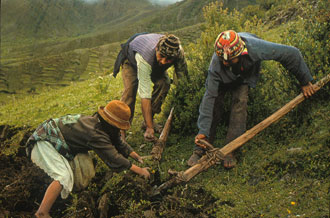
|
|
"The constellation Pleiades, also called the Seven Sisters"
© Anglo-Australian Observatory/Royal Observatory, Edinburgh.
|

|
|
A family prepares a field for potato planting, with two men using a local tool (the foot-plow) and a woman turning over a clod of earth.
(Photo by Ben Orlove)
|
Toward the end of every June, indigenous farmers in the high Andes of Bolivia and Peru look to the stars for a hint of what the weather holds six months down the road. If the 11-star constellation known as the Pleiades appears bright and clear in the pre-dawn sky, they anticipate early, abundant rains and a bountiful potato crop. If the stars appear dim, however, they expect a smaller harvest and delay planting in order to reduce the adverse impact of late and meager precipitation.
In a paper published in the Jan. 6 issue of Nature, a team of scientists from the Lamont-Doherty Earth Observatory examine this centuries-old practice to reveal the science behind the folklore. Not only does the technique work reasonably well, it turns out that the farmers have in effect been forecasting El Niño for at least 400 years, a capability modern science achieved less than 20 years ago.
"It's actually quite a brilliant scheme," Lamont-Doherty climate researcher and co-author Mark Cane said. "The method involves a great deal of nuance. I still wonder how they possibly worked it out. It's really quite a feat."
Cane, who with Lamont-Doherty colleague Stephen Zebiak devised the modern El Niño forecasting technique, was on a sightseeing excursion in Peru in 1995 when his guide mentioned something about a local farmer who looked to the pre-dawn sky during the festival of San Juan for clues about the coming summer wet season. Seasons in the Southern Hemisphere are opposite those in the north, with the height of summer coming in December, January and February.
There were two distinct possibilities. Either it was pure mythology or El Niño was somehow involved, Cane said. "No other weather phenomenon would present symptoms that far in advance, and Andean droughts are known to occur in El Niño years. It was intriguing."
Back in the 1970s, the practice had also caught the attention of environmental anthropologist Ben Orlove, who also happens to be a childhood friend of Cane's from Flatbush in Brooklyn. Orlove, on the faculty of the Department of Environmental Science and Policy at the University of California, Davis and now also an adjunct researcher at Lamont-Doherty, published an anthropology paper in 1979 detailing the practice in all its variations from village to village.
While reviewing the literature on the practice, Cane came across Orlove's name and their collaboration was born.
"It would be safe to say that hundreds of thousands of peasant farmers in the Andes practice this folk art," Orlove said. "It has a lot of vitality as a group activity around which whole villages make their agricultural plans. It's the most important predictive technique they have, and intimately tied to their spiritual and religious traditions."
The specifics of the observational technique differ from village to village, with four to five separate visual attributes examined in various combinations over periods ranging from about 10 days to just one -- June 24, the festival of San Juan. In almost every case, the results are used to plan the coming planting schedule and estimate the prospective harvest.
What Cane noticed was that the four primary attributes observed -- overall brightness, overall size, the date of first appearance and the position of the brightest star in the cluster -- all depend on the relative clarity of the atmosphere, which is in turn sensitive to moisture content.
In a synthesis and review of existing data, the team looked for a correlation between high cloud cover over the central Andes in June, actual precipitation from October through February, and the subsequent potato harvest. What they found was a relationship between a brewing El Niño and the increased incidence of high, virtually transparent clouds over the Andes that dim the farmers' view of the stars. Four to eight months later, the El Niño results in a hot, dry growing season that reduces the potato yield.
"Their method is elegant, surprisingly accurate and for them intuitive," Orlove said. "It's really a matter of big, bright Pleiades equals big rain equals big potato harvest, versus small, dim Pleiades equals small rain equals small potato harvest."
"But what really sets them apart," Orlove said, "is the fact that they strategically apply this forecast information." In that sense they are ahead of scientifically advanced countries like the U.S., where farmers generally plant on the assumption of an average year and deal with the consequences of abnormalities as they arise.
"I don't know of anything like this anywhere else in the world, but I'm looking," Orlove said. "There's a lot we can learn from these types of folkloric practices about how to disseminate and apply our own scientific knowledge."
Cane, Orlove and Zebiak are affiliated with the Columbia Earth Institute, which fosters collaboration between physical and social scientists in order to better understand the earth and our complex relationship with it.
|
